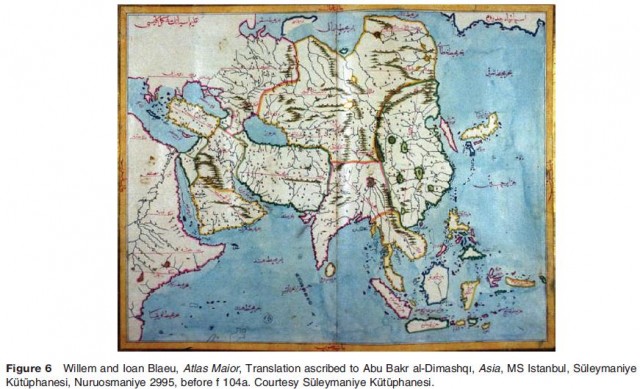Cultures of Mapmaking
Mapmaking in Islamic societies took its themes, methods, techniques, and formats from several societies that either existed before the emergence of Islamic societies or parallel to them. The regions where these societies flourished were Greece, Egypt, Iran, India, China, Spain, Italy, the Netherlands, and France. With the shifts and changes in Europe since the sixteenth century, further European societies became relevant to cartographic activities in various Islamic societies, among them Russia, German countries, and Great Britain.
The two earliest appropriations of cartographic products and practices from other cultures, which shaped mapmaking in Islamic societies for more than 500 years, occurred during the eighth and ninth centuries in Abbasid Baghdad and other regions of the empire. One of the two crosscultural encounters is represented through the translations of Ptolemy's Geography into Arabic during the ninth century and their subsequent appropriation and adaptation to the interests of scholars. These translations were made in the circle of the Abbasid courtier and son of the Arab governor of Kufa, the philosopher Abu Yusuf Ya'qub b. Ishaq al Kind? (d. c. 260 h/874), and the Sabean moneylender, mathematician, astronomer, philosopher, and theologian Thabit b. Qurra (d. 288 h/901). The other encounter had its basis in a series of maps of possibly Sasanian origin that were reproduced in Arabic, although it is unclear when this took place. These maps were adapted during the ninth and tenth centuries to the new political and religious powers and structures in Iran, the Arabian Peninsula, and Northern Africa. Step by step the original set of maps was enriched by maps of new regions of the Islamic world and accompanied by descriptions of the mapped territories and their cultures.
The two encounters led to different views on how to organize and represent the world and its parts. Maps in the tradition of Ptolemy's Geography worked with projections, latitudes and longitudes, grids, occasionally scales, and the theory of astronomically defined climates, mostly seven in number. They often contain short references to uninhabitable parts of the earth due to excessive cold or heat derived from Aristotelian physics and meteorology. The geographical space represented in such maps was first and foremost the entire world. It was mapped as a sphere or as a semisphere. Over time, such world maps focused more and more on the Islamic world. But certain regions of the world outside of Islamic societies continued to be reported about such as China, Sri Lanka, Byzantium, or the land of the Slaves. In addition to the world maps, maps of oceans, seas, rivers, and islands are extant from this cartographic encounter. These local maps show clear non Ptolemaic features. They may be the result of the mapmakers' efforts to translate textual and oral geographic information into images. The people involved in this cartographic tradition were primarily scholars of the mathematical sciences which comprised in Islamic societies in continuation of earlier Greek models number theory, geometry, theory of proportions, and astronomy. The most important representatives of this tradition in Islamic societies were the lost maps produced in the early ninth century for the Abbasid caliph al Ma'mun (r. 198–218 h/813–33), the maps extant in Muh.ammad b. Musa al Khwarazm?'s (fl. late second early third century h/late eighth early ninth century) Surat al'ard. (image/form of the earth), the maps extant in copies of the new Arabic translation of Ptolemy's Geography made by Georgios Amirutzes (d. 1475) and his son for the Ottoman Sultan Mehmet Fatih (r. 849 h/1444 and 855–86 h/1451–81), and the maps found in the geographical chapter of texts on 'ilm al hay'a (mathematical cosmography) such as Nizam al D?n al N?sabur?'s (d. 730 h/1329) Tawd?hor Sharhal Tadhkira (explanation of or commentary on the 'Memoir') (Figure 1).
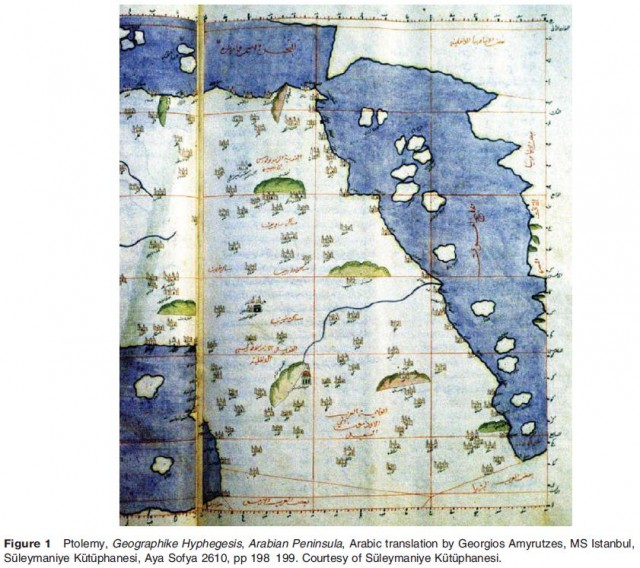
Maps derived from possible Sasanian models worked with geometrical figures such as circles, semicircles, crescents, triangles, rectangles, ovals, and straight lines to represent regional units, directions, and distances. Their focal points are the postal and pilgrimage routes within the Abbasid Empire and other Islamic states, for instance, in al Andalus and the main parts that formed the Abbasid caliphate. The views on what these parts were and which rank each part assumed in relationship to the others depended largely on the outlook the mapmaker and commentator subscribed to – a preference for Iranian cultural values, a preference for Islamic values, or a preference for his own environment and travel experiences. The set of maps created within this tradition included as a rule a world map and in most cases 21 regional maps. Most of the world maps in the extant manuscripts show the world as a full circle; but there are also manuscripts from as early as the tenth century and as late as probably the seventeenth or eighteenth century that show the world as a bird. The distribution of the regions over the body of the bird varies. China or Arabia can be found as the head. India, the land of the Khazars in the Northern Caucasus Mountains, Asia, or Africa fill the wings. The tail is taken up by Northern Africa or Europe. The world maps show cosmological concepts such as al Bahr al Muh?t (the Encompassing Sea) also known from much earlier cultures and religious concepts specific to the Qur'an and other sources of Muslim belief such as the barzakh, a small, narrow land barrier that separates the two main oceans of the maps, that is, the Indian Ocean and the Mediterranean Sea. The main Quranic meaning of barzakh is, however, not geographical, but eschatological. It denotes the life of the soul after the death of the body until the Day of Judgment. The provinces and regions in these world maps are mostly registered in form of rectangular tables or stripes of boxes. They also include countries outside the Islamic world such as India or China. A few cities such as Mecca or Alexandria, rivers and occasionally their sources, islands and tribes are also noted. The regional maps focus entirely on the Islamic world. They map Iran, Central Asia, parts of the Caucasus Mountains, the Arabian Peninsula, Iraq, the Fertile Crescent, Northern Africa, and three seas (the Persian Sea that is the Indian Ocean;
the Mediterranean Sea; the Caspian Sea). The sequence of the mapped regions and their relative delineation differs from my naming them in the sense that most extant manuscript maps show the following order and content: Arabia; Persian Sea; al Maghrib (Northwest Africa); Egypt; Syria; Mediterranean Sea; al Jazira (Northern Iraq and Southeast Turkey); Iraq (Central and South Iraq); Khuzistan; Fars; Kirman (parts of Iran); Sind (part of Pakistan); Armenia, Arran, Azerbaijan (part of Caucasus Mountains, Azerbaijan, and Iran); Jibal; Daylam, Rayy, Tabaristan (parts of Iran), Caspian Sea; Persian Desert; Sijistan; Khurasan (parts of Iran, Turkmenistan, Pakistan, Afghanistan); and Mawara' al nahr (part of Uzbekistan) (Figure 2).
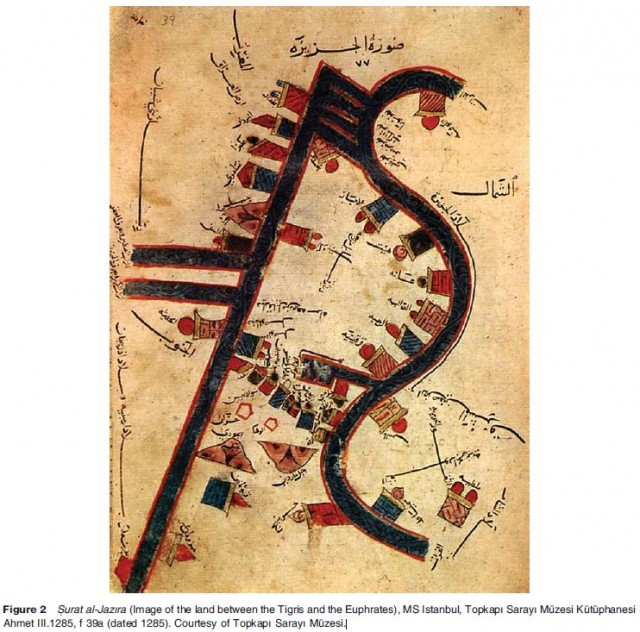
The people creating maps and writing texts in this cartographic tradition were mostly members of the Abbasid administration for which they worked as officers of the postal routes or of the finances, philosophers, and scholars of religious disciplines, or wealthy, independent travelers and merchants. After its first famous practitioner, the geographer, mathematician, astronomer, physician, philosopher, and student of al Kind?, Abu Zayd Ahmad b. Sahl al Balkh? (d. 322 h/934), this tradition is called the Balkh? school of geography. Other major representatives of this school were Abu Ishaq Ibrah?m b. Muhammad al Istakhr? (fourth century h/tenth century), Abu l Qasim Muhammad b.Hawqal (d.c. 367 h/977), and Abu 'Abdallah Muhammad b. Ahmad al Muqaddas? (d. c. 390/1000). The earliest maps surviving from this body of works belong to a manuscript of Ibn Hawqal from 479 h/1086 extant in the Topkap? Saray? Muzesi Kutuphanesi in Istanbul.
The most pervasive feature of maps in Arabic, Persian, and Ottoman Turkish after the centuries of translation, adoption, and adaptation is, however, their combination of more than one cultural tradition of cartography. World maps attached to geographical, cosmographical, or historical texts combine between the eleventh and the sixteenth century elements of the Ptolemaic tradition with the components of the Balkh? school to which their makers added further elements taken from the Qur'an and contemporary developments in politics, commerce, war, or demography. Mount Qaf, another Quranic concept, appears for instance as a mountainous ring enclosing the Encompassing Sea in maps joined to geographic manuscripts such as Abu 'Abdallah Muhammad b. al Sharf al Idr?s?'s (495– c. 560 h/1100– c. 1165) Nuzhat al mushtaq f? 'khtiraq al afaq (The Pleasant Journey of Those Who Desire to Travel through Faraway Lands), to texts seen as popularizing scientific ideas such as Zakariya' al Qazw?n?'s (d. 682 h/1283) Kita 'aja'ib al makhluqat f?ghara'ib al mawjudat (Book of Marvels of Things Created and Miraculous Aspects of Things Existing), and to texts of a more religious character such as the Khar?dat al 'aja'ib wa far?dat al ghara'ib (The Unbored Pearl of Wonders and Precious Gem of Marvels) attributed to Siraj al D?n Abu Hafs. 'Umar b. al Ward? (d. 861 h/1457). The maps to The Book of Curiosities, a twelfth century manuscript on astronomy, geography, commerce, and wondrous things copying a work of the eleventh century, include already the famous circular map ascribed to al Idr?s?. It also has a rectangular world map and maps of the Indian Ocean, the Mediterranean Sea, Cyprus, Sicily, maps of great rivers such as the Nile, the Euphrates, and the Tigris, maps of the former Fatimid capital al Mahd?ya and the Egyptian town of Tinn?s, and maps of lakes. The author, in all likelihood a Fatimid custom officer, combined conceptual and technical elements of the Ptolemaic tradition such as climate zones, geographical coordinates, a scale, and the configuration of the Old World with symbolic features from al Khwarazm?'s maps such as the depiction of the Mountains of the Moon as sources of the Nile and conceptual and representational elements of the Balkh? school such as the representation of rivers by straight lines or lakes by circles to which he added information from travelers, texts, and perhaps administrative documents. He chose some unique and not yet well understood forms of representation for the Mediterranean Sea and the Indian Ocean (an oval) and for Cyprus (a rectangle divided into smaller units of rectangles and text) (Figure 3).
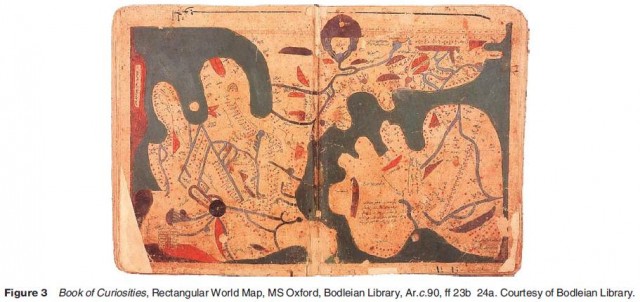
Al Sharf al Idr?s? and his geographical and cartographic work represent another kind of cross cultural encounter since he lived in more than one of the Mediterranean cultures. He was born in Ceuta, received his education in al Andalus, and traveled widely in the Islamic world. Then he worked for two Norman kings, Roger II (r. 1097–1154) and William I (r. 1154–66) at their court in Palermo. At the end of his life, he returned to the Islamic world, possibly to Ceuta. Conceptually, he followed Ptolemaic cartographic theory and methods. He produced two sets of new maps. One was a circular world map engraved on a silver plate, which is lost. The other is a set of 70 regional maps drawn on paper. They are extant in various manuscripts across the world. Al Idr?s? planned to combine them into one large rectangular map of the known world stretching from 1801 in the east in the S?la Island (Korea) to the prime meridian in the west running through the Fortunate Isles. Presenting Roger not only as a successful conqueror and master of politics, he described him as the head of the cartographic project who decided on what geographical and cartographic truth was. One method applied for sorting out conflicting information was to trace with iron instruments on a drawing board all data on longitudes, latitudes, and distances. Al Idr?s? wrote two, perhaps even three geographical texts, all of them lavishly illustrated with regional maps portraying the entire world in a combination of Ptolemaic concepts with ideas and symbols taken from the Balkh? school. He also had access to non Arabic oral and perhaps written sources and provided fresh information about the physical and cultural geography of European lands, not available previously in Arabic.
Almost all of Ottoman mapmaking is best described as a highly flexible merging of cartographic and artistic languages from all major cultural traditions the Ottoman Empire drew upon, cooperated and traded with, and fought against. While these mergers are often seen as a reflex of Ottoman cultural and scholarly inferiority, the cultural dynamics and force that brought forth such mergers cannot be overrated. If nothing else, the people involved in producing such eclectic maps were capable of reading and understanding different geographical concepts, philological descriptions, and iconographic representations. A fair amount of concrete cross cultural work was needed in order to interpret foreign maps and make their copies and translations into Ottoman Turkish acceptable for the local consumer. As is well known and can be demonstrated for a number of the preserved Ottoman maps designed from the sixteenth to the eighteenth centuries, even the copyists participated in this process of cross cultural adaptation.
Four major cultures of mapmaking arose in the Ottoman realm. Two of these cultures, the making of portolan charts and the creation of maritime handbooks with maps of Mediterranean islands, coasts, and fortresses, were closely interconnected. They combined several previous mapmaking traditions from different Mediterranean cultures, mainly Arabic, Catalan, and Italian portolan charts, regional maps, and isolarii. They were apparently primarily designed by members of the Ottoman navy. Scribes and painters from imperial as well as commercial workshops participated in executing the fine copies. Specialized mapmaking workshops existed in the middle of the seventeenth century in Istanbul. Almost all extant specimens were made for acquiring courtly patronage or to be given away as gifts. In particular the maps illustrating the various copies of P?r? Re'?s' (c. 875–961 h/1470–1554) two versions of the Kitab i Bahr?ye (Maritime Handbook) are wonderful products of art. Some of them show the inclusion of Renaissance painting techniques, while others are splendid experiments in colors and symbolic interpretations of physical objects (Figure 4).
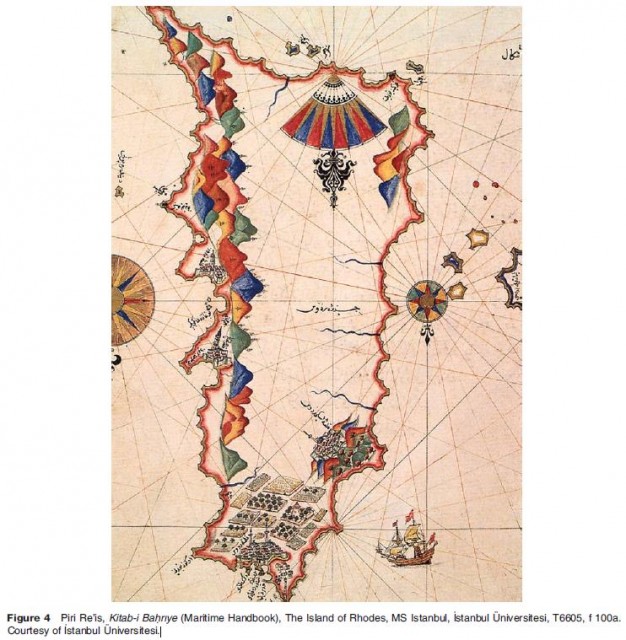
The two other main Ottoman mapmaking cultures were situated directly in the courtly sphere. One of them consists of town views and itineraries in official histories mapping Ottoman military campaigns, adversaries, and imperial architecture. Their execution was the task of the painters of the imperial painting workshops. As a result, many are superb exemplars of Ottoman fine arts. (Figure 5).
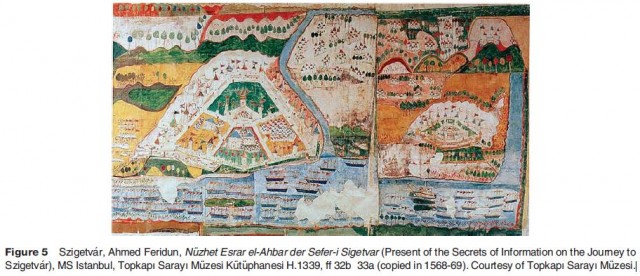
The other mapmaking culture began to appear during the sixteenth century when Arabic and Persian models of world maps became to be replaced gradually by models from Italy and then from the United Provinces, France, and German countries. Partial or full translations of books on the New World, a Latin edition of Ptolemy's Geography, Abraham Ortelius' Theatrum Orbis Terrarum, Gerard Mercator's and Henricus Hondius' Atlas Minor, Willem J. and Joan Blaeu's Atlas Maior, and other geographical and cartographic works produced in different Catholic and Protestant countries of Europe were undertaken by Ottoman scholars, often in collaboration with members of the religious minorities living in the Ottoman Empire or with converts from Catholic or Protestant Europe. The maps of these books had a profound impact on Ottoman mapmaking. The changes, however, did not constitute a unilateral Westernization, to use an anachronistic term. Translators, scholars, copyists, calligraphers, painters, and trainees, and teachers of the Ottoman army transformed the translated maps in a variety of ways into maps accessible to Ottoman spectators and situated them firmly within Ottoman visual, geographic, and literary cultures (Figure 6).
